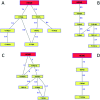Functional and protective hole hopping in metalloenzymes
- PMID: 34760183
- PMCID: PMC8565380
- DOI: 10.1039/d1sc04286f
Functional and protective hole hopping in metalloenzymes
Abstract
Electrons can tunnel through proteins in microseconds with a modest release of free energy over distances in the 15 to 20 Å range. To span greater distances, or to move faster, multiple charge transfers (hops) are required. When one of the reactants is a strong oxidant, it is convenient to consider the movement of a positively charged "hole" in a direction opposite to that of the electron. Hole hopping along chains of tryptophan (Trp) and tyrosine (Tyr) residues is a critical function in several metalloenzymes that generate high-potential intermediates by reactions with O2 or H2O2, or by activation with visible light. Examination of the protein structural database revealed that Tyr/Trp chains are common protein structural elements, particularly among enzymes that react with O2 and H2O2. In many cases these chains may serve a protective role in metalloenzymes by deactivating high-potential reactive intermediates formed in uncoupled catalytic turnover.
This journal is © The Royal Society of Chemistry.
Conflict of interest statement
There are no conflicts of interest to declare.
Figures









Similar articles
-
Electron flow through biological molecules: does hole hopping protect proteins from oxidative damage?Q Rev Biophys. 2015 Nov;48(4):411-20. doi: 10.1017/S0033583515000062. Q Rev Biophys. 2015. PMID: 26537399 Free PMC article. Review.
-
Hole hopping through tyrosine/tryptophan chains protects proteins from oxidative damage.Proc Natl Acad Sci U S A. 2015 Sep 1;112(35):10920-5. doi: 10.1073/pnas.1512704112. Epub 2015 Jul 20. Proc Natl Acad Sci U S A. 2015. PMID: 26195784 Free PMC article.
-
Could tyrosine and tryptophan serve multiple roles in biological redox processes?Philos Trans A Math Phys Eng Sci. 2015 Mar 13;373(2037):20140178. doi: 10.1098/rsta.2014.0178. Philos Trans A Math Phys Eng Sci. 2015. PMID: 25666062 Free PMC article.
-
Living with Oxygen.Acc Chem Res. 2018 Aug 21;51(8):1850-1857. doi: 10.1021/acs.accounts.8b00245. Epub 2018 Jul 17. Acc Chem Res. 2018. PMID: 30016077 Free PMC article.
-
Expansion of Redox Chemistry in Designer Metalloenzymes.Acc Chem Res. 2019 Mar 19;52(3):557-565. doi: 10.1021/acs.accounts.8b00627. Epub 2019 Feb 28. Acc Chem Res. 2019. PMID: 30816694 Review.
Cited by
-
Electron transfer in polysaccharide monooxygenase catalysis.Proc Natl Acad Sci U S A. 2025 Jan 7;122(1):e2411229121. doi: 10.1073/pnas.2411229121. Epub 2024 Dec 30. Proc Natl Acad Sci U S A. 2025. PMID: 39793048 Free PMC article.
-
Tryptophan to Tryptophan Hole Hopping in an Azurin Construct.J Phys Chem B. 2024 Jan 11;128(1):96-108. doi: 10.1021/acs.jpcb.3c06568. Epub 2023 Dec 25. J Phys Chem B. 2024. PMID: 38145895 Free PMC article.
-
Tryptophan-96 in cytochrome P450 BM3 plays a key role in enzyme survival.FEBS Lett. 2023 Jan;597(1):59-64. doi: 10.1002/1873-3468.14514. Epub 2022 Oct 27. FEBS Lett. 2023. PMID: 36250256 Free PMC article.
-
The crystal structure of CbpD clarifies substrate-specificity motifs in chitin-active lytic polysaccharide monooxygenases.Acta Crystallogr D Struct Biol. 2022 Aug 1;78(Pt 8):1064-1078. doi: 10.1107/S2059798322007033. Epub 2022 Jul 27. Acta Crystallogr D Struct Biol. 2022. PMID: 35916229 Free PMC article.
-
Probing the Role of Cysteine Thiyl Radicals in Biology: Eminently Dangerous, Difficult to Scavenge.Antioxidants (Basel). 2022 Apr 29;11(5):885. doi: 10.3390/antiox11050885. Antioxidants (Basel). 2022. PMID: 35624747 Free PMC article. Review.
References
Publication types
Grants and funding
LinkOut - more resources
Full Text Sources

